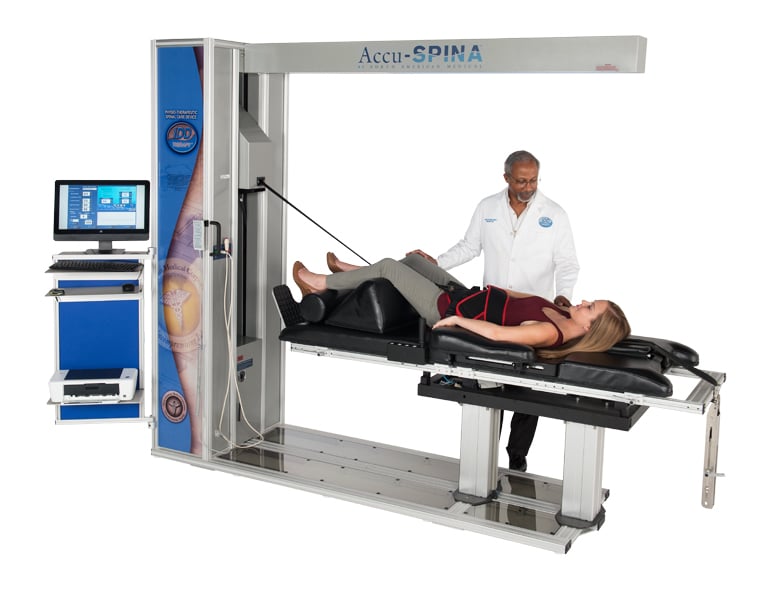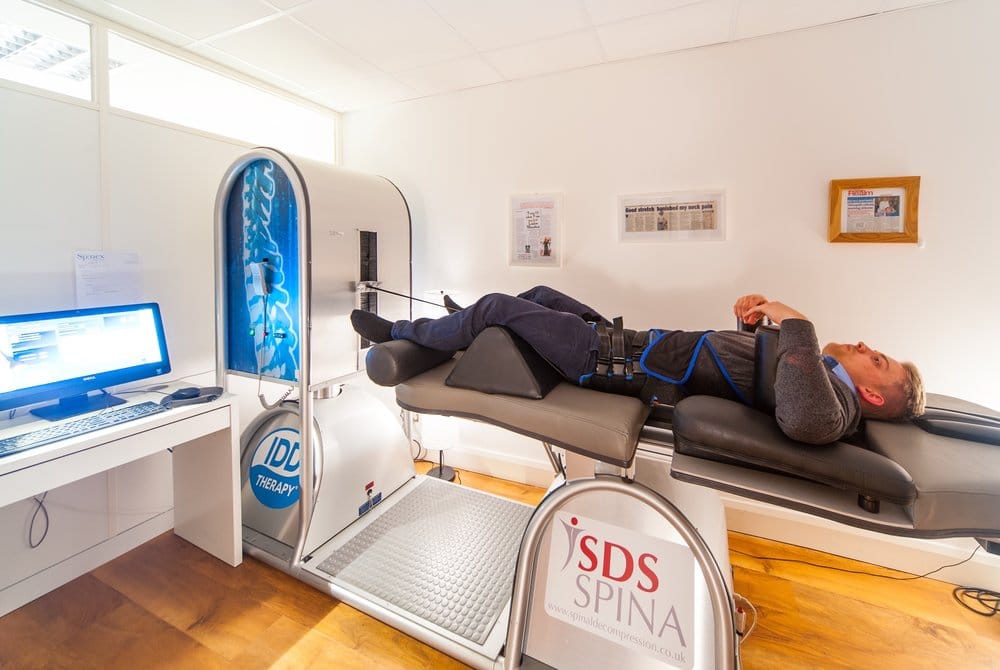If you mention sciatica to someone who has suffered from it and they will invariably think back to an unpleasant and painful time.
I spoke to Dan Plev, Consultant Spinal Neurosurgeon at The London Clinic who explains the best route to treating your sciatica
The term sciatica is used to describe a pain experienced in the nerves which leaves the lower back and passes through the buttocks and/or legs. It can be felt as a dull ache, shooting pain or numbness and can occasionally cause weakness in the legs.
Unlike some pain which comes and goes, sciatica is often constant. There is no escape from it and this is why it causes misery. Fortunately, in most cases, the pain will subside with a bit of time because our body is able to heal itself. However, when the pain doesn’t pass, there is a variety of treatment options.
Treatments range from medication, manual therapy and exercise, to non-invasive IDD Therapy disc treatment. When non-invasive treatment is not working, we may consider injections and in some cases, surgery is the appropriate treatment route.
Sciatica explained
Our bodies are controlled by electrical signals sent through the nerves to all areas of our body. Nerves exit the spinal column at every level, branching off from our spinal cord. The sciatic nerve is formed by nerves exiting the lower part of the spinal column; the “lumbar spine”.
The sciatic nerve branches out into smaller nerves which control the bottom half of our body. They run like electrical wires through our buttocks and legs. When something interrupts or irritates these nerves, they deliver a pain signal to the brain and that can be felt as sciatica.
There are a variety of causes of sciatica but usually, the origin is the lower back. Our spine is made of a stack of bones like cotton reels (vertebrae). Between the vertebrae, we have cushion-like discs or intervertebral discs which act as spongy shock absorbers as we move.
The discs are also important because they create a gap between the solid vertebrae. The gaps create space for the nerves to pass as they branch off from the spinal cord.
There are two main issues which can affect the nerves:
Disc problems: The discs have a strong outer wall made of tough fibrous collagen (annulus fibrosus). Inside the disc is a gel-like substance (nucleus pulposus) which has high water content and provides shock-absorbing properties.
If the centre of the disc pushes out against, or even through, the disc wall it can touch or put pressure on the nerve. This “bulging” or “herniated” disc can press on the nerve and or cause chemical irritation to the nerve leading to pain.

Narrowing between the vertebrae: If the gap between the vertebrae in the lower back narrows, this can reduce the space for the nerve. When there is pressure on the nerve, this can result in sciatic pain.
The reduction in the space between the vertebrae can be caused by a loss of disc height. Over time our discs lose water. Rather like a deflated bicycle tyre, if the disc loses water it can also lose height, thus narrowing the gap between the vertebrae. This can pinch a nerve.
Alternatively, or as a result of the loss of disc height, the body can add more bone to a vertebra to strengthen it. The disc carries a certain proportion of our bodily load. If there is an issue with the disc and it takes less of the weight, then more load is placed on to our bones.
In order to support the additional load, the body reinforces the vertebra by adding more bone. That additional bone can lead to a loss of space for the nerves. This additional bone is described as spinal stenosis. With less space for the nerve they can again become “pinched” and the nerve pressure causes pain.
Options for treatment
Injections
There are different types of injection. The most common injection given by doctors for sciatica is aimed at reducing inflammation.
Inflammation is a natural process of healing. However, after prolonged periods, the inflammation itself can become a problem and excessively irritate the nerves, thus causing pain.
A steroid injection can be given which helps to neutralise the inflammation and relieve pain. It is important to make the distinction – corticosteroids for pain relief in medicine are different from anabolic steroids which are performance-enhancing drugs.
Injections are usually given to create a pain-free window, whereas the other treatments described here address the causes of the problem.
Manual Therapy and Exercise
Manual therapists will use a range of stretching and mobilisation techniques to increase the flexibility of the soft tissues and alleviate the stiffness in the joint. Pain creates a vicious cycle where we can’t move but it is the movement which is so important for the cure!
The goal is to create some movement in the spine and to unload the disc and the joints. Sometimes the soft tissues even become stuck together (adhesions) which prevents movement. Part of the manual therapy and stretching will aim to address that.
For many patients, the word exercise conjures up memories of PE lessons and cross country running. But as movement is restored and pain subsides, certain exercises, which anyone can do at home, are important. These are designed to help to move the joints of the spine and hips, in particular. Exercise keeps them active, strong and engaged so that they can support their share of load as we move.
Combined with gentle walking these simple exercises help to keep our spines healthy and prevent further episodes of pain.
IDD Therapy Disc Treatment

IDD Therapy (Intervertebral Disc Decompression) is a non-surgical spinal decompression treatment. When pain from a bulging or herniated disc persists and has not responded to manual therapy, therapists use IDD Therapy as a tool to help take pressure off targeted discs and to gently mobilise the spine.
IDD Therapy is a mechanical tool which replaced old-style traction. It uses computer-controlled pulling forces to open the space between the vertebrae to decompress the disc and gently mobilise the soft tissues and joints with some soft oscillation. The goal is to relieve pain and help restore movement.
Patients lie on the Accu SPINA machine which delivers IDD Therapy. They are connected to the machine using ergonomic harnesses and pulling forces are applied at specific angles to treat the affected spinal level.
The IDD Therapy lasts for 25 minutes and patients remain completely relaxed throughout. A series of treatments are given and the forces used are gradually built up as the body adapts to the changes.
IDD Therapy is combined with some other modalities, such as heat, and is provided in combination with manual therapy and strengthening exercises as part of a programme of care.
Surgery
Surgery is the preferred treatment for sciatica when either the pain is intolerable and has not responded to other non-invasive treatments or the pressure on the nerve is such that it is causing weakness, usually in the legs or in very extreme cases, a loss of bladder or bowel control (cauda equina).
If a disc in the spine has herniated, this is where the centre or nucleus of the disc has pushed out through the walls of the disc.
Sometimes only a small amount of the nucleus has pressed through the wall, or it can be substantial. Usually the body can reabsorb this disc material, however, if it remains, it can become hard and leave patients in constant pain.
The most common surgery given is called a microdiscectomy. This is where a small incision is made in the lower back and using surgical instruments, the piece of disc material is removed. This surgery can be very effective in relieving leg pain.
If the space where the nerve lies is narrowed, other forms of “decompression” surgery can be used where small pieces of bone are removed to create space for the nerve or to remove bone which is pressing on it.
It is important to stress that long-term pain relief is best achieved if the causes of the weakness are addressed.
Urgent surgery: Where a patient is experiencing weakness in their legs this is a more serious proposition and usually surgery will be considered early.
Weakness or a loss of leg power can mean that the nerve is at risk of damage and thus relieving the pressure quickly is very important. Surgery is also usually given as a priority if there is a loss of bowel or bladder function.
Whilst surgeons and therapists see a lot of patients with back pain, in some ways sciatica is the condition which causes the most stress and anxiety.
Surgery and invasive treatments are only necessary in a small percentage of cases. The advances in conservative (non-invasive) care mean that most sciatica can be addressed without the need for surgery. Clinicians work together to match the right option for the right condition.
My final words on sciatica is that prevention is always better than cure. Staying mobile, keeping active and avoiding prolonged sitting are key to looking after your back and keeping sciatica at bay.
